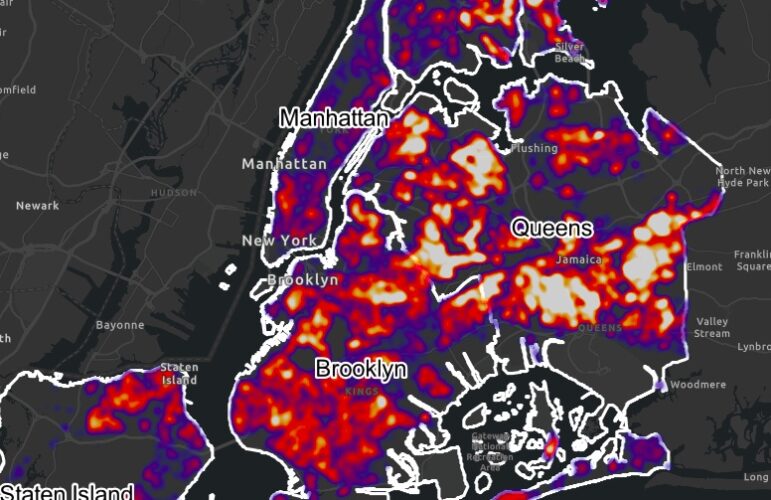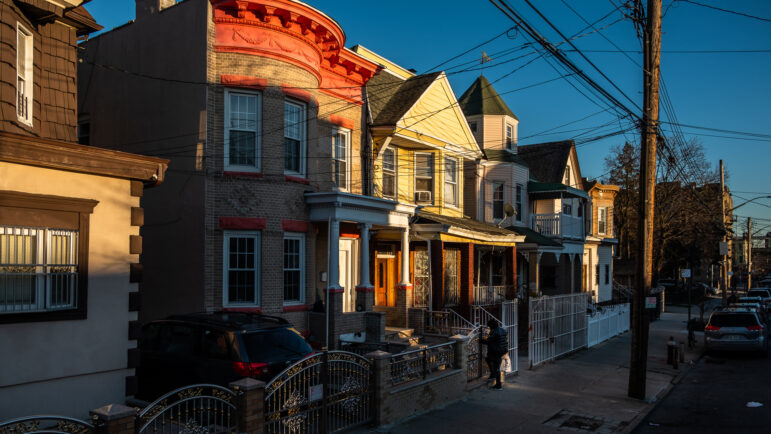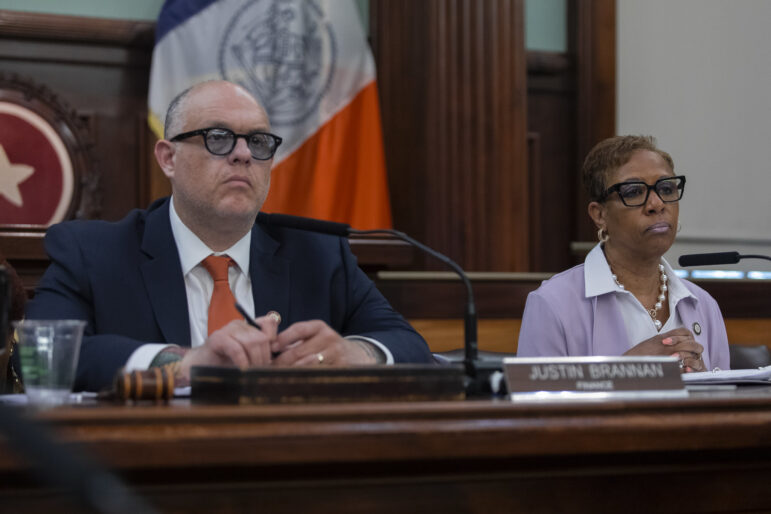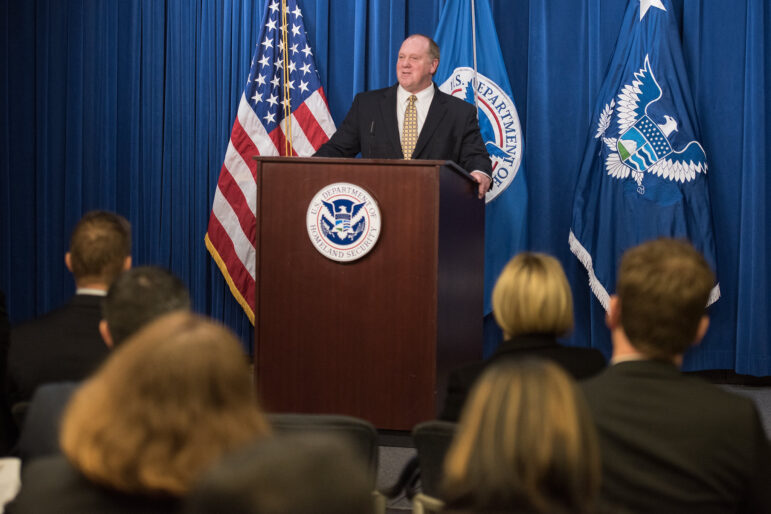
Ed Reed/City Hall
HRA Commissioner Banks and Mayor de Blasio. Banks says the city is taking a multifaceted approach to defending tenants.
On June 18, two men walked down Fulton Street* and rang the doorbell of Cypress Hills Local Development Corporation (CHLDC), a well-known community organization in East New York and a key participant in local discussions over the city’s plan to rezone the neighborhood.
They announced themselves as tenant “specialists” and city employees. According to Julia Watt-Rosenfeld*, CHLDC’s director of community organizing and advocacy, the two employees had never heard of CHLDC, and wanted to learn about the organization and find out whether the staff had heard of Mayor de Blasio’s affordable housing plan. They carried a flier that described the benefits of the plan and advised readers to call 311 if they were facing landlord harassment. Some CHLDC staff members were confused about what agency had employed the specialists, and were taken aback by their basic questions about the neighborhood and tenant organizing.
At that time, Watt-Rosenfeld had been waiting for news from the Human Resources Administration (HRA) of an upcoming Request for Proposal granting money to community organizations to connect tenants to the city’s expanded free legal services. But now that these two tenant specialists had shown up, Watt-Rosenfeld wondered: Had the city decided to hire its own team, rather than give funds to organizations with proven tenant leadership programs?
City celebrates groundbreaking initiative
The “Tenant Support Unit” may have made a bad first impression in Cypress Hills, but the city says its new outreach unit is part of an unprecedented effort to empower tenants against landlord harassment.
HRA is sending dozens of workers to knock on doors, canvas streets and attend community events to inform residents about de Blasio’s Anti-Harassment Tenant Protection Program, an initiative announced in February to guarantee free legal services to tenants in neighborhoods that the city wants to rezone. The outreach unit is modeled on the mayor’s Pre-K For All enrollment initiative, which used dozens of organizers to reach into communities and help families enroll in pre-K.
While the city hopes its rezoning plan will help the de Blasio administration achieve its goal of building and preserving 200,000 units of affordable housing over the next ten years, the city has also acknowledged that investment in rezoning neighborhoods will incentivize landlords to use illegal measures to push out existing tenants. The city hopes improving access to legal services will stave off displacement in these neighborhoods, while correcting the historical disadvantage of indigent tenants battling the lawyers of moneyed landlords.
The outreach effort is the brainchild of Steven Banks, the HRA commissioner and former attorney-in-chief of the Legal Aid Society, who says that during his 33-year stint at Legal Aid, he repeatedly called on the city to “put people on the ground” and help residents gain access to civil court lawyers. He called the initiative a “huge sea-change in government approach to this serious problem that’s festered for many years.”
But with a strange lack of information available about the Tenant Support Unit and widespread anxiety over the administration’s rezoning plans, some organizations in rezoning neighborhoods have reacted with skepticism. They are concerned that the city’s organizing efforts will undermine their own work by misinforming tenants about the rezoning plan, and they question why the city hasn’t instead funneled more resources to their own tenant programs.
Multifaceted approach
Banks insists that the agency does value community organizations, which is why their anti-harassment program has three prongs: legal providers, community groups, and city canvassers. Using all three to reach tenants will ensure “there’s no stone unturned in the effort to prevent tenant harassment,” says Banks.
In the fiscal year that ended in June, HRA expended $5 million on expanded contracts with legal service providers Legal Aid and Legal Services NYC as well as a number of community organizations that support tenants, including NY Communities for Change, Community Action for Safe Apartments (CASA), Make the Road, MinKwon Center for Community Action, and others.
The third prong—the city’s new outreach team—is just getting started. HRA is in the midst of hiring 31 specialists, five borough leaders and one field manager to conduct outreach in the seven neighborhoods targeted for a rezone: six specialists for East New York, eight for Jerome Avenue in the Bronx, 12 for East Harlem and Inwood, six for Flushing and Long Island City, and another two for Bay Street Corridor in Staten Island. Though not all the specialists have been hired, the teams began their work in East New York about three weeks ago and are ramping up in other neighborhoods. Canvassers document reports of harassment, help residents connect to the appropriate city agencies and legal services and conduct follow-up visits.
By the 2017 fiscal year than will begin next July, the Anti-Harassment Tenant Protection program’s budget will grow to $36 million, with at least $2 million for community organizations, and provide about 14,000 tenants in housing court with lawyers, according to The New York Times. The Tenant Support Unit will be funded separately, to the tune of $4.3 million. This fall, HRA intends to release new RFPs, one calling for legal service providers and another for more community organizations to conduct outreach.
So far, about 1,100 households in 20 buildings have received some form of assistance through the program. For instance, the city is now providing legal help to 55 residents in East New York whose new owner has refused to fix leaks or exterminate vermin. In the past three weeks, the Tenant Support Unit team has knocked on about 2,000 doors, held approximately 1,000 conversations, and made about 160 referrals to city services, according to City Hall Press Secretary Wiley Norvell.
Organizers concerned
CHLDC’s Julia Watt-Rosenfeld described her organization’s encounter with the specialists to the Coalition for Community Advancement, an alliance of organizations seeking to reform East New York’s rezoning plan. Coalition members were immediately concerned.
“The lack of prior notice of the existence of this tenant engagement team and that the team would be canvassing in the neighborhood is disrespectful to the community and Coalition,” Coalition members wrote in a letter to city officials. “It would be far better to…make concrete commitments to the community than to create a separate ‘engagement’ team to convince residents of the merits of the local plan before it is fully developed,” they wrote.
The coalition requested more information about the canvassers’ purpose and training, and also asked why the city had not instead provided more resources to organizations with roots in the community. “We (and others) have been mobilizing the community for months and encouraging residents and small business owners to get involved in the city process and believe, therefore, that we know who is best qualified to perform the role that these outreach workers were sent to perform,” the letter continued.”
Though Make the Road, MinKwon and CASA received HRA funding last year to assist tenants to gain access to legal services, organizers at all three organizations said the city had not provided information about the Tenant Support Unit.
“I’ve learned more about [the Tenant Support Unit] from reporters than I’ve heard about it from the administration,” says Susanna Blankley, director of CASA, who was still trying to find out the names of the Bronx canvassers. She also criticized the administration for lacking a serious plan to prevent displacement caused by rezoning, saying the city was “more focused on numbers than it is on people”—including number of affordable units built and doors knocked.
“Informing people about their rights is not going to be very effective when those rights are very weak,” says Nick Petri of Make the Road in Staten Island. About 85 percent of units in Staten Island’s Bay Street Corridor, which is targeted for rezoning, are unregulated, so it’s possible that landlords will remove tenants using completely legal measures. Furthermore, both he and Blankley expressed concern that the city’s outreach work might be superficial and short-lived, failing to build the type of tenant leadership required to challenge powerful landlords.
But Aaron Jones, an organizer at Community Voices Heard who has been involved in the Harlem rezoning plan, said that while he hadn’t heard much about the effort, he believes it is a good step forward: “I think it’s great the city has a plan that actually has an outreach component because it is important to have as many people as possible informed in the community,” he says, adding that an outreach program would be especially effective if specialists were hired from the community.
City defends approach
Michael DeLoach at the Office of the Mayor apologized to CHLDC for not informing them about the outreach team, and explained that the specialists were hired solely for the purpose of tenant protection, not for promoting the mayor’s housing plan, according to Watt-Rosenfeld.
Banks and Norvell emphasized the importance of using both community organizations and a city outreach team to help tenants gain access to legal services. Each entity, they said, has its own advantages: While community organizations have deep networks in communities, city canvassers have a more direct relationship to other city agencies, and legal providers are required to take cases referred by the city.
Judith Goldiner of the Legal Aid Society said she agreed with Banks’s multi-pronged approach, and said that city workers also have access to data—such as the location of bad landlords and the addresses of Section 8 voucher holders—that could help them target at-risk tenants.
Responding to the specific incident at Cypress Hills, Norvell explained the specialists’ behavior. “There’s a sort of organizing 101, which is before we go out, we make sure we walk through the neighborhood.” The specialists were not in the middle of canvassing, he says, but were “orienting themselves.”
Specialists are hired based on their communication skills. While residency in the rezoning area is not required, the city is looking for candidates who can speak the languages of the neighborhood. The city completed its first round of hires through internal staff referrals from HRA, social service schools, referrals from the PreK For All Outreach initiative, and the Mayor’s Office of Appointments. Norvell says that the second round of hires will include a more public posting.
Banks says he had not heard criticism of the program prior to City Limits’ inquiry, and said he would make sure to address community organizations’ concerns. Yet he stressed his belief in the city taking an active role in outreach, which he hopes will be a long-term effort that spreads to other city departments.
“After many years of neglecting communities across the city, “the administration is putting substantial resources on the ground to communities that need it,” Banks says.”
* The original version of this story misstated the location as Jamaica Avenue and used different spellings of Watt-Rosenfeld’s name.
City Limits’ coverage of housing policy is supported by the Charles H. Revson Foundation.
* * * *










2 thoughts on “City’s Tenant Protection Effort Breaks Ground and Ruffles Feathers”
Pingback: Flood Of Permits, Ebb Likely |
I am a 50 yr old woman with a spinal injury as well as other issues that is on supportive housing being threatened of losing my housing which ive had since 2008 all necause i called 311 because the landlord refused to remove dog soaked urine carpet from previous tenants and the deadline for eviction is at the end of this month.please help me , i have no where else to go.